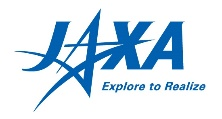 |
 |
 |
~ 国際宇宙ステーションからEthernet経由で光地上局が高精細度画像を受信 ~
国立研究開発法人宇宙航空研究開発機構(理事長:山川宏 以下、JAXA)および国立研究開発法人情報通信研究機構(理事長:徳田英幸 以下、NICT)と株式会社ソニーコンピュータサイエンス研究所(代表取締役社長:北野宏明 以下、ソニーCSL)は、国際宇宙ステーション(ISS)の「きぼう」日本実験棟に設置した小型光通信実験装置「SOLISS」(Small Optical Link for International Space Station)とNICTの宇宙光通信地上局(以下、光地上局)※1との間で双方向光通信リンクを確立し、Ethernet経由での高精細度(HD)画像データ伝送に成功しました。これは、小型衛星搭載用の光通信機器としてEthernetによる通信を実現した世界初の事例となります。
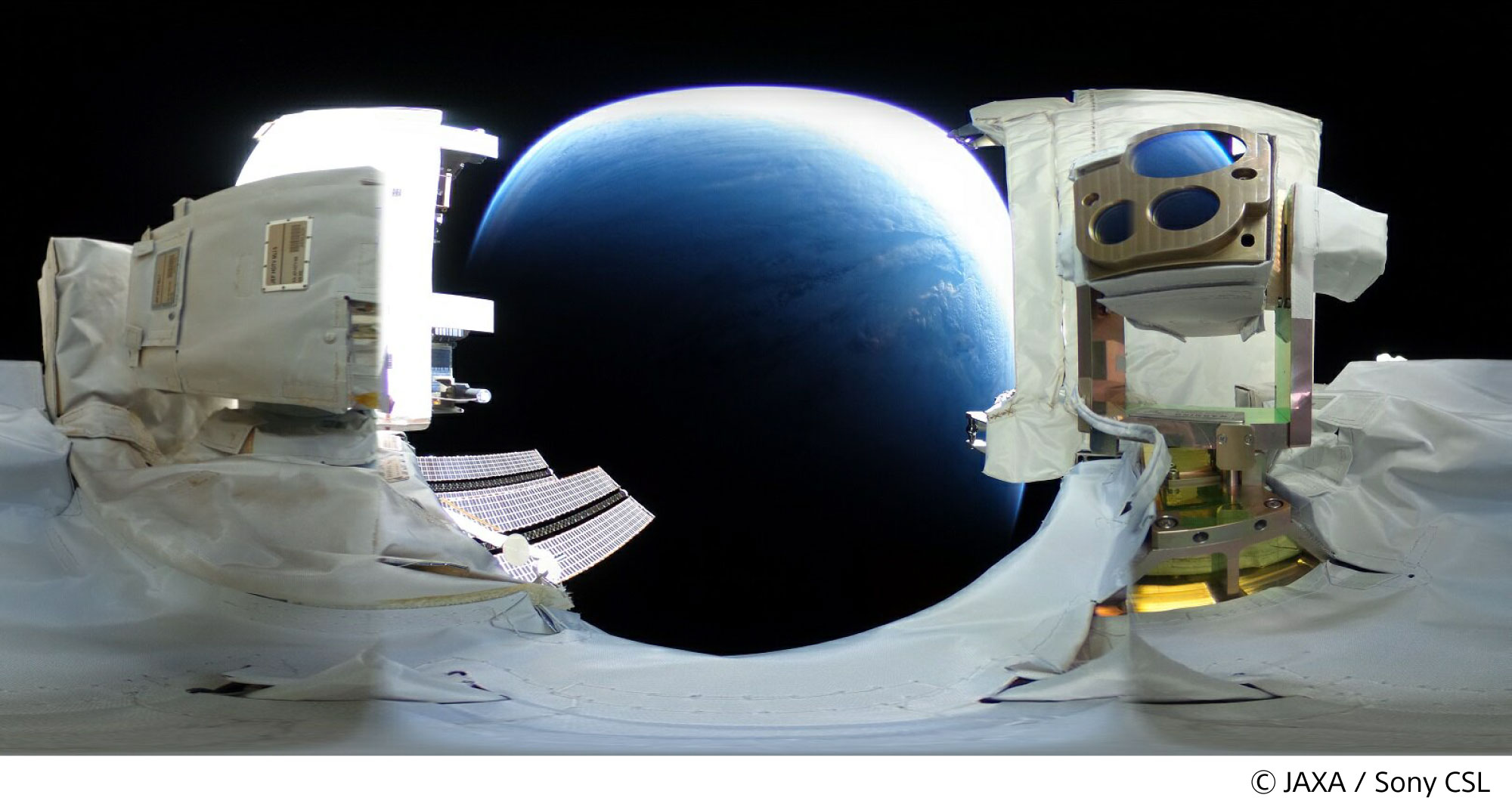
「SOLISS」は2019年9月にISSの「きぼう」船外実験プラットフォームに設置され、その後、軌道上と光地上局との間で双方向光通信リンクを確立すべく、各種パラメータを調整しながら天候を踏まえつつ毎週一回程度の頻度で通信試験を行ってきました。その結果、2019年10月25日に光地上局への光ダウンリンク(指向制御)を確立し、2020年3月5日には「SOLISS」と光地上局との間で波長1.5µmレーザ光による双方向光通信リンクの確立に成功しました。さらに3月11日には「SOLISS」から 100 MbpsのEthernetによる通信を用いてHD画像を光地上局で受信することに成功しました。
JAXAとソニー株式会社は、JAXA宇宙探査イノベーションハブの研究提案の枠組みを利用して、将来の衛星間や地上との大容量リアルタイムデータ通信の実現を目指し、2016年より共同で研究を行ってきました。※2 2017年からはソニーCSLが基盤研究を引き受け、JAXAとソニーCSLは長距離空間大容量データ通信を目的とする「SOLISS」を共同開発しました。光通信部にはソニー株式会社が長年培ってきた光ディスク技術が使用されています。
JAXAは、「きぼう」日本実験棟の有償利用制度※3を通じて、2019年9月に宇宙ステーション補給機「こうのとり」8号機にて「SOLISS」をISSへ送り届け、「きぼう」日本実験棟の船外実験プラットフォームにある中型曝露実験アダプター(i-SEEP)に設置しました。
NICTとソニーCSLは「SOLISS」と光地上局との間の双方向通信実証に向けて2018年より共同で研究を実施してきました。NICTは「SOLISS」の開発にあたり、NICTが保有している衛星搭載用光通信ターミナルの開発技術を基にした知見を提供し、「SOLISS」軌道上実証試験に必要な計測や実験を共同で行ってきました。
今回の双方向光通信実験の成功は、NICTが実験運用に関連した技術支援を行い、i-SEEP上における「SOLISS」の軌道上運用をJAXAが支援しながら、ソニーCSLが通信試験を実施した結果となります。
光には電波と比べて高速大容量の通信を可能とする特長があります。今回、既に確立された光ディスク技術と標準規格であるEthernetによる光双方向通信実験が成功したことによって、今後の宇宙空間における地球周回軌道を始めとした衛星間や地上との超高速(低遅延)データ通信や、大容量リアルタイムデータ通信の実現や汎用化などが期待されます。
今後、JAXA、NICT、ソニーCSLは実験結果の詳細な解析及び評価を実施する予定です。
また、「SOLISS」による通信の安定性の向上などを目指した実験運用は2020年6月初旬頃まで継続する予定です。
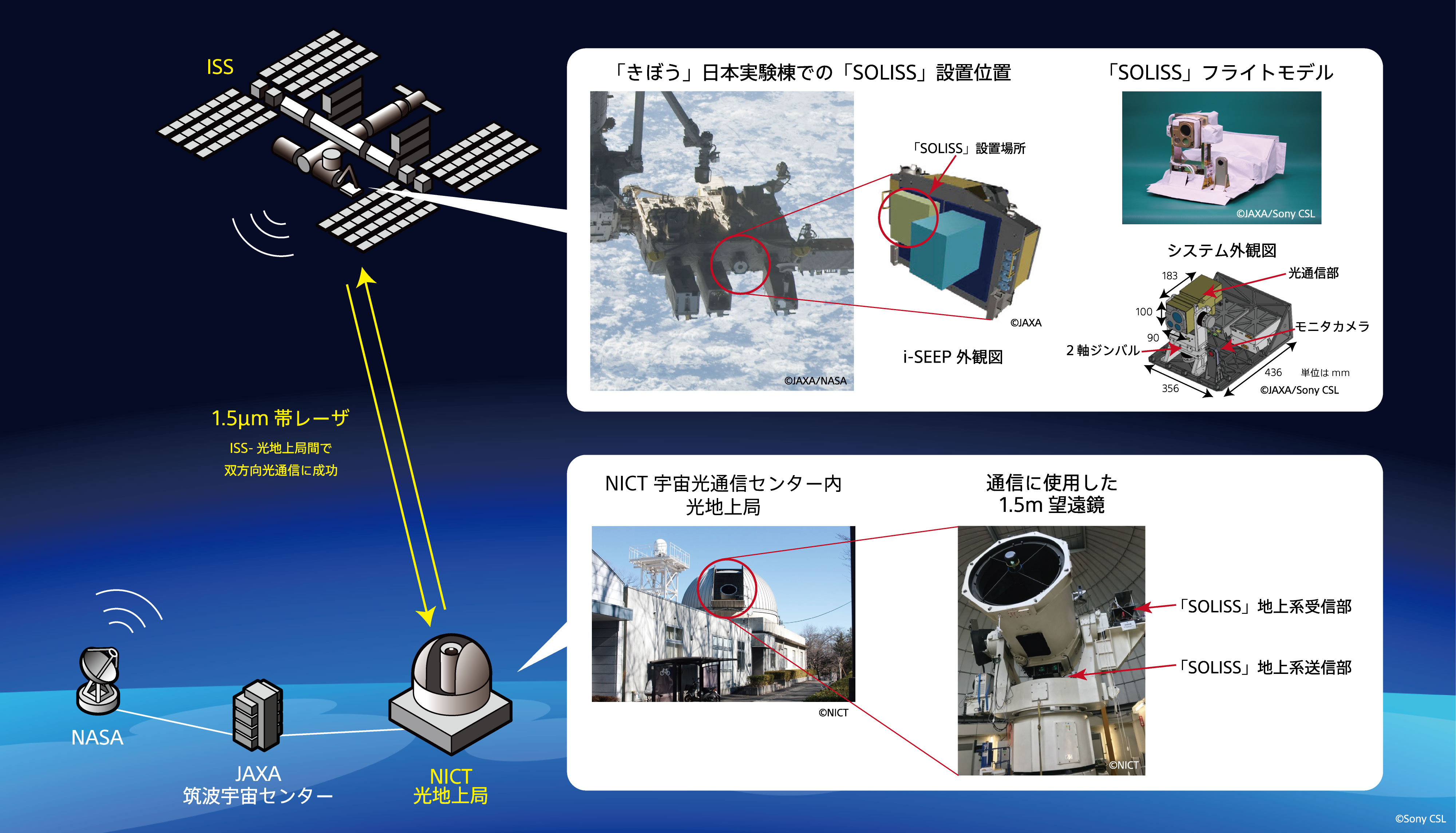
◆NICT理事 門脇直人のコメント
NICTは、前身の郵政省電波研究所の時代から50年以上にわたり、日本の衛星通信技術の研究開発を先導してきました。今回、NICTが長年培ってきた光衛星通信技術及び知見を活用し、「SOLISS」による民間主導の研究開発により、宇宙と地上間の双方向光通信という快挙を達成できたことを嬉しく思います。この技術は、従来の静止衛星だけでなく、現在構築が進みつつある低軌道衛星メガコンステレーションによるブロードバンド衛星通信システム等における利活用も期待されています。今後、商用化に向けた技術開発の進展に期待します。
◆ソニーCSL社長 北野宏明のコメント
ソニーが長年培ってきた光ディスク技術では、1mm以下のとても短い距離で光を制御していますが、今回、この技術が宇宙と地上間という長距離空間でも適用可能なことが実証されました。この技術は高精度、低消費電力だけでなく、機器が小型で量産が容易になることから、今回の実験成功が今後の社会実装や事業化に向けた重要なマイルストーンになったと捉えています。2015年のJAXA宇宙探査イノベーションハブの研究提案からスタートした研究が、JAXAとNICTの協力による、「きぼう有償利用制度」によるトライ&エラーを繰り返すことができる宇宙実証環境及びNICT光地上局の実証設備の利用により、短期間で世界初の宇宙通信の具現化につながりました。
※1 NICT光地上局
宇宙通信に係わる技術を開発するために設置された望遠鏡施設。東京都小金井市に口径1.5m、1.0m、茨城県鹿嶋市に口径1.0m、沖縄県国頭郡恩納村に口径1.0mの計4基の望遠鏡が設置されている。
※2 JAXAが国立研究開発法人科学技術振興機構から受託した「イノベーションハブ構築支援事業」(「太陽系フロンティア開拓による人類の生存圏・活動領域拡大に向けたオープンイノベーションハブ」)において、「長距離空間光通信を実現する光通信モジュールに関する研究」を共同で行う契約を2016年に締結。
※3 科学研究や技術開発へのニーズに応えるため、国内の民間企業等を主な対象として、利用者が独自の目的で「きぼう」を有償で利用し、利用成果を独占的に取得・使用することが可能なJAXAの制度。
国立研究開発法人宇宙航空研究開発機構 広報部
国立研究開発法人情報通信研究機構 広報部報道室 publicity@nict.go.jp
株式会社ソニーコンピュータサイエンス研究所 広報窓口 csl-pr@csl.sony.co.jp
 |
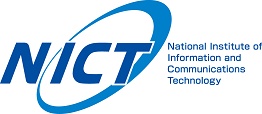 |
 |
– Optical ground station receives high-definition images from the International Space Station via Ethernet –
The Japan Aerospace Exploration Agency (JAXA, President: Hiroshi Yamakawa), the National Institute of Information and Communications Technology (NICT, President: Hideyuki Tokuda) and Sony Computer Science Laboratories, Inc. (Sony CSL, President and CEO: Hiroaki Kitano) announced today that they were successful in establishing a bidirectional laser communication link between SOLISS (Small Optical Link for International Space Station), installed in the Exposed Facility of the Japanese Experiment Module (JEM) “Kibo” of the International Space Station (ISS) and the optical ground station for satellite communications (hereinafter, optical ground station) *1 of NICT, and in transmitting high-definition (HD) image data via Ethernet. This marks the first time in the world that bidirectional symmetric Ethernet links have been established by using laser communication devices designed for small satellites.

The SOLISS system was installed on the Kibo’s exposed facility on the ISS in September 2019. Since then, in order to establish a bidirectional laser communication link between the on-board system and the optical ground station, communication tests have been conducted about once a week, weather permitting, while making adjustments to various parameters.
As a result, on October 25, 2019, an optical downlink (orientation control), a fine pointing control from SOLISS to the optical ground station was successfully established, and on March 5, 2020, bidirectional laser communication link with the optical ground station using a laser beam (with a wavelength of 1.5 µm) was successfully established. Furthermore, on March 11, HD images were successfully received at the optical ground station from SOLISS via 100 Mbps Ethernet.
JAXA and Sony Corporation have been conducting joint research since 2016 with the aim of establishing real-time, mass-data communication system for future inter-satellite communications and communications with ground stations under the Request for Proposal (RFP) joint study framework of the JAXA Space Exploration Innovation Hub Center.*2 Starting in 2017, Sony CSL undertook the task of basic research, and JAXA and Sony CSL jointly developed SOLISS for the purpose of realizing mass-data communication over long distances. The optical communication unit employs the optical disc technology that Sony Corporation has cultivated over many years.
JAXA sent the SOLISS system to the ISS via the H-II Transfer Vehicle (HTV8) “KOUNOTORI-8” in September 2019 using the Kibo’s paid utilization program.*3 The system was attached to the IVA-replaceable Small Exposed Experiment Platform (i-SEEP) hardware adapter installed on the Kibo’s exposed facility.
NICT and Sony CSL have been jointly conducting research since 2018 for the purpose of demonstrating bidirectional communication between SOLISS and the optical ground station. NICT provided the knowledge based on the development technology of the optical communication terminal for the on-satellite system, and they jointly carried out the measurements and experiments necessary for SOLISS in-orbit demonstration.
The success of this bidirectional laser communication experiment is the culmination of efforts from the each parties, where Sony CSL conducted communication testing while NICT provided technical support related to experimental operation, and JAXA supported the in-orbit operation of the SOLISS system on i-SEEP.
The benefit of laser communication compared to radio wave is the physical ability to scale its bandwidth. The success in bidirectional laser communication demonstration using long-established optical disk technology and the Ethernet standard will likely create a pathway to ultra-high speed (low latency) data communication, and real-time mass-data communication for cross-links between satellites and between a satellite and ground stations in the future.
JAXA, NICT and Sony CSL will proceed in carrying out detailed analysis and evaluation of the experimental results. Futhermore, experimental operation aimed at improving communication stability using SOLISS is planned to continue until early June 2020.
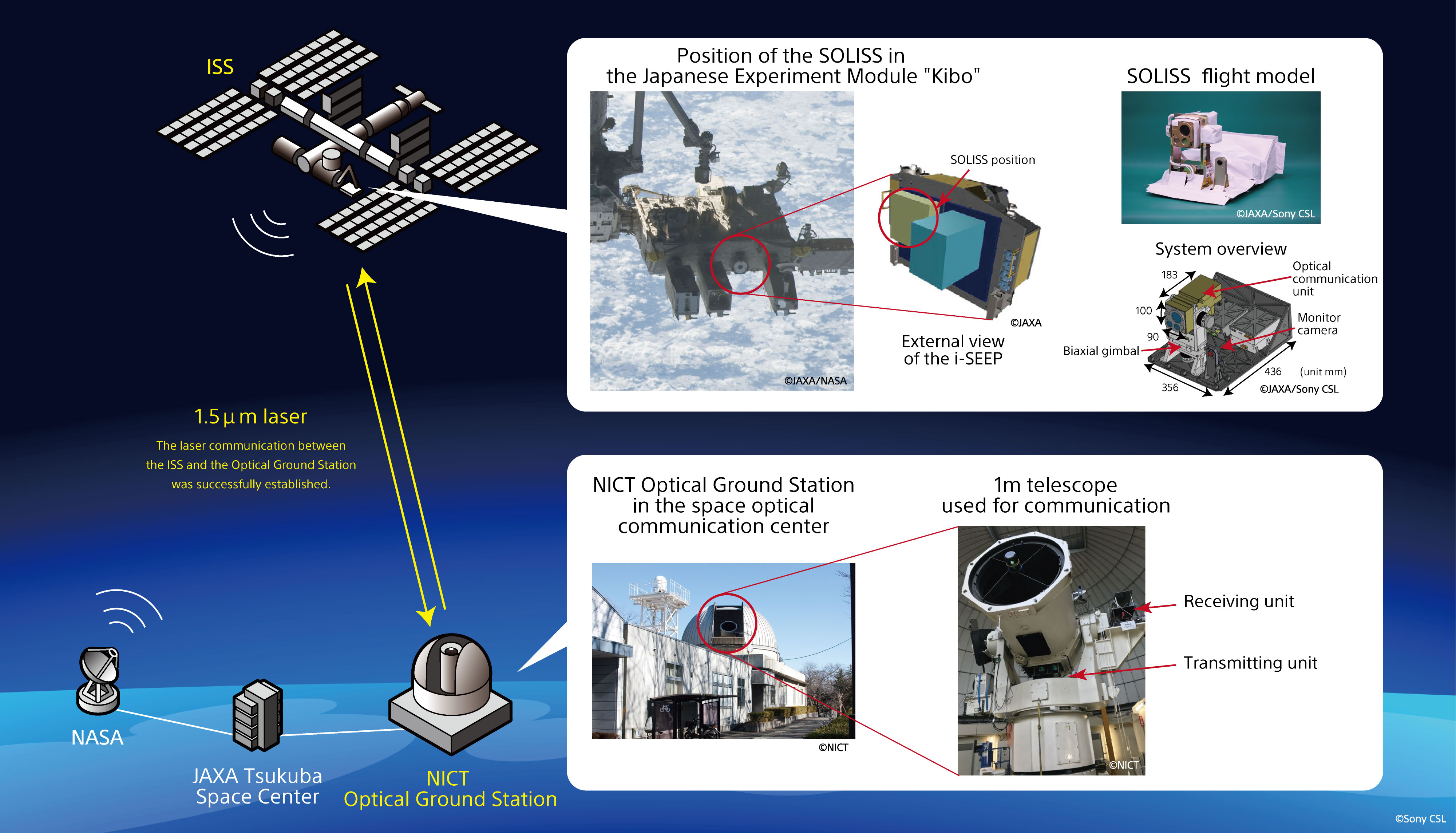
Hiroshi Sasaki, Vice President and Director General for Human Spaceflight Technology Directorate, JAXA, remarked: “The Japanese Experiment Module (JEM) “Kibo” of the International Space Station (ISS) is a permanent experimental facility located in low earth orbit about 400 kilometers above the earth. The maximum utilization of the value of Kibo, which enables long-term verification testing with the support of astronauts, has turned into a meaningful opportunity to expand the use of the ISS for civilian use and technical demonstration, as outlined in the Basic Plan on Space Policy. I am very pleased with the achievement to establish bidirectional laser communication between space and the ground via SOLISS. I anticipate this technology, which originated from our Space Exploration Innovation Hub Center program, will serve as the basis for realizing mass-data communication with orbiting spacecrafts around the earth in future space exploration such as to the Moon and Mars.”
Naoto Kadowaki, Vice President, NICT, said: “NICT has been leading the research and development of Japanese satellite communication technology for over 50 years since the days of its predecessor, the Radio Research Laboratory, Ministry of Posts and Telecommunications. I am glad that NICT has achieved the feat of bidirectional laser communication between space craft in orbit and ground stations through the private-led research and development program while utilizing the optical satellite communication technology and knowledge that NICT has cultivated over many years. We hope that this technology will be used not only in conventional geostationary satellites, but also in broadband satellite communication systems using Low Earth Orbit satellite mega-constellations, which are currently under construction. I hope that this technology will reach to the level for commercialization in the near future.”
Hiroaki Kitano, President of Sony CSL, remarked: “The optical disc technology that Sony has cultivated over the decades controls light at a very short distance of 1 mm or less, but this time it has been proved that this technology can be applied even in long-distance, between space and ground. This technology is not only high precision and low power consumption, but also provides new opportunities due to its small size and mass production technologies. We regard the success of this experiment as an important milestone for future development and commercialization. The research started in 2015 as a part of the JAXA Space Exploration Innovation Hub Center program. With the respective joint research projects with JAXA and NICT, we were able to achieve the successful results this time in a short period of time by using their existing space programs, platforms and equipments that allowed us to implement agile processes in the development of SOLISS.”
*1 NICT Optical Ground Station: A telescope facility installed to develop technology related to space communications. The station has a total of four telescopes with apertures of 1.5m and 1.0m in Koganei, Tokyo, 1.0m in Kashima, Ibaraki, and 1.0m in Onna, Kunigami-gun, Okinawa.
*2 Studies implemented based on the JAXA-Sony agreement concluded in 2016 for conducting fundamental and feasibility studies on long-distance communication system with free-space laser link technologies as part of JAXA’s “Open Innovation Hub for Expanding Humanosphere and the Domain of Human Activity through Solar System Frontier Development,” a project commissioned by the Japan Science and Technology Agency (JST) under its innovation hub start-up support program.
*3 The Kibo’s paid utilization program of JAXA to enable mainly for private companies in Japan to use Kibo on their initiatives in order to meet the needs of scientific research and technological development and to benefit form an exclusive right to use the result of their initiatives.
JAXA Public Affairs Department : https://global.jaxa.jp/activity/pr/inquiries/index.html
NICT Press Office, Public Relations Department : publicity@nict.go.jp
Sony CSL Corporate Communications Office : csl-pr@csl.sony.co.jp
◆JAXA理事・有人宇宙技術部門長 佐々木宏のコメント
国際宇宙ステーションの「きぼう」日本実験棟は、上空約400キロメートルという地球低軌道にある恒久的な実験施設です。宇宙飛行士の支援を受けながら長期間にわたって実証実験ができる「きぼう」の価値が最大限に活用されたことは、宇宙基本計画が示す、ISSの民間利用や技術実証利用の拡大につながる有意義なきっかけとなりました。改めて「SOLISS」による宇宙と地上間の双方向光通信を達成できたことを嬉しく思います。宇宙探査イノベーションハブから生まれたこの技術が月や火星など将来の宇宙探査における地球周回軌道との大容量通信を実現するための礎となることを期待しています。